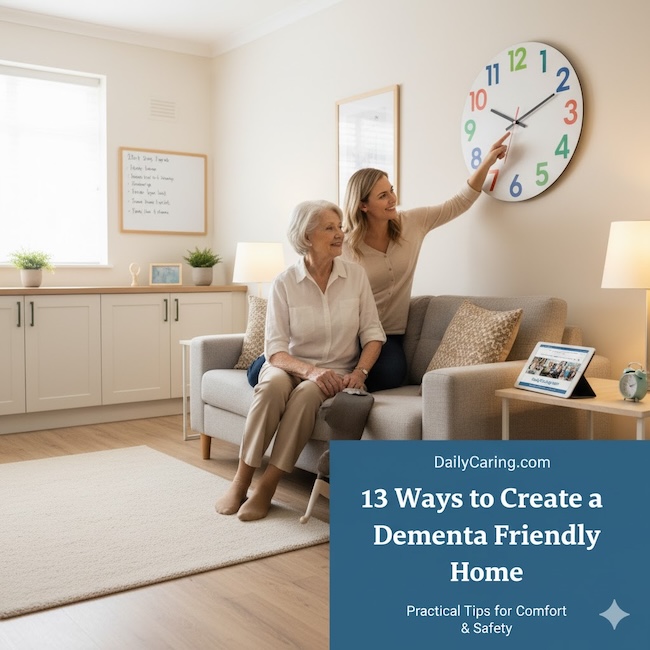When words fail, your silent language speaks volumes. For a loved one with dementia, who may struggle to process spoken sentences, your posture, your expression, and the energy you carry become the primary conversation.
A furrowed brow or rushed gesture can broadcast stress, escalating their confusion, while calm, open body language can be a lifeline to connection. Mastering this non-verbal dialogue isn’t just a technique—it’s a profound way to offer safety and love without saying a word.

Let’s explore how your physical presence can become your most powerful tool for fostering peace and understanding.
Use Calm and Positive Body Language When Speaking to Someone with Dementia
Communicating with someone with Alzheimer’s disease or dementia can be made easier with some new techniques.
Damage to their brain has changed the way your older adult hears, processes, and responds to conversation.
That’s why it’s necessary to adapt our communication to match their abilities.
Often, the nonverbal messages we send with our body language and facial expressions come through more clearly than the words we speak.
And sometimes the nonverbal messages don’t match the words we use, which can confuse.
But when we use body language and facial expressions that help seniors clearly and easily understand our meaning, it reduces confusion, agitation, and anger, and also increases cooperation.
Using these nonverbal communication techniques to talk to someone with dementia makes caregiving easier and improves the quality of life for both of you.
We explain what nonverbal communication is and share six helpful tips that you can start using today.
What are “Non-Verbal Dementia Communication Techniques”?
There are many different types of nonverbal communication, including:
1. Facial expressions
Your face can express emotions without saying a word. And many facial expressions are the same across cultures, like happiness, sadness, anger, surprise, fear, and disgust.
2. Body movements and posture
The way someone moves and carries themselves can say a lot about them, their mood, and their state of mind.
3. Gestures
When we talk, we use gestures without even thinking about it – waving, pointing, and using our hands when we’re angry or excited.
4. Eye contact
For people who can see, vision is the dominant sense. That’s why eye contact is so important.
The way you look at someone can say a lot. Plus, eye contact helps you gauge the other person’s level of engagement and reactions.
5. Touch
Touch is another way to “speak” without using words.
For example, these mean very different things: a limp handshake, a gentle shoulder tap, a warm hug, a reassuring pat on the back, a patronizing pat on the head, or a controlling grip on the arm.
6. Space
Everyone needs some physical space, though how much may vary from person to person and situation to situation.
For example, standing too close can make someone uncomfortable. But staying too far a distance could seem uncaring or uninterested.
7. Voice
The tone and volume of your voice add a lot of meaning to words.
For example, imagine saying “fine” during a heated argument compared to saying it when you’re happy and content. The same word sounds completely different.
6 Non-Verbal Dementia Communication Techniques
1. Be patient and calm
- Project a positive and calm attitude – it can help your older adult communicate more easily
- Avoid body language that shows frustration, anger, or impatience
- Try not to interrupt them
- Please give them your full attention
When a situation is very frustrating, staying calm can be tough.
In those cases, it’s worthwhile to step away for a minute to do some deep breathing or calming exercises so you can come back with a calm attitude.
That helps you avoid a situation where your tension or frustration could subconsciously influence your older adult’s responses or behavior.
2. Keep voice, face, and body relaxed and positive
- Have a pleasant or happy look on your face – a tense facial expression could cause distress and make communication more difficult
- Keep your tone of voice positive and friendly
3. Be consistent
Avoid confusion by making sure your body language and facial expressions match the words you’re speaking.
4. Make eye contact and respect personal space
- Approach from the front so they can see you coming and have a chance to process who you are and the fact that you’re going to interact with them
- Don’t stand too close or stand over them – it can feel unsafe
- Keep your face at or below their eye level. This helps them feel more in control of the situation
- Make and maintain eye contact while having a conversation
5. Use a gentle touch to reassure
Physical touch can offer comfort and reassurance, but be sure to observe to ensure they’re comfortable with the touch.
This could include:
- Shaking hands
- Patting or holding their hand
- Patting or rubbing their shoulder or back
- Putting an arm around them
- Giving a hug
6. Observe their nonverbal reactions
Dementia may make it difficult for your older adult to express themselves verbally.
Watch for signs of frustration, anger, or fear and adjust your responses and actions to calm or soothe as needed.
Final Thoughts on Talking to Someone with Dementia
Transforming your body language is an act of compassion that benefits you both. As you consciously slow your movements, soften your gaze, and open your posture, you are not just managing a behavior; you are building a bridge to a shared moment of calm.
This practice has a remarkable boomerang effect: the serenity you project soothes your loved one, and their calm, in turn, replenishes your own patience. Start with a straightforward shift today, and discover how the quiet power of your presence can become the cornerstone of more peaceful, connected days.
Recommended for you:
- How to Talk to Someone with Alzheimer’s: Short, Direct Sentences
- 6 Positive Ways to Approach Someone with Dementia
- Solve Challenging Alzheimer’s Behaviors with Expert Communication Tips
About the Author

Connie is the founder of DailyCaring.com and was a hands-on caregiver for her grandmother for 20 years. (Grandma made it to 101 years old!) She knows how challenging, overwhelming, and all-consuming caring for an older adult can be. She also understands the importance of support, especially in the form of practical solutions, valuable resources, and self-care tips.













Very helpful and reassuring advice, my husband has the onset of dementia and is very mean. Your article really helped put this situation into perspective and thank you so much for the tips on how to respond in a loving and positive way ❤️Also the comments from other people going through this are very helpful that I am not alone or a bad person for my feelings., To everyone who is a caregiver to their loved one I hear you, this is a horrible sad situation but as a community we can lift each other up 🙏Thank you sending ❤️
You’re absolutely not a bad person and certainly aren’t alone. Dementia is challenging for everyone involved. We’re so glad this article is helpful 💜
Great site for caregivers. Currently myself and my patient are dealing with hallucinations/delusions. Any thoughts on how to deal with this would be most appreciated. Thanks for all you do.
We’re so glad our articles are helpful. We’ve got an article about hallucinations that might be helpful at https://dailycaring.com/10-ways-to-respond-to-dementia-hallucinations-in-seniors/
My husband has been in ‘residential care. now for 2 months. he is 73 years old, This is the worst time in our 55 years married . what happens to all the other ‘baby boomers’ who don’t have a computer???
Have to say, happy to find your site. A little overwhelmed at the moment, didn’t know so many people are going through the same thing. Have to say, I have dealt with his cancer (bowel,liver, spine) over the last 4 years) Sorry to say, I wish he had got run over by a bus. Is that the worst thing a wife can say. I just want the ‘suffering’ to stop
We’re so sorry to hear about all that you’re dealing with right now with your husband’s health conditions. You’re certainly not alone in wishing that the suffering will end 💔
In case you’re interested, you might find joining a caregiver support group to be helpful. In person ones can be tougher to get to, especially now, but there are also plenty of them online as well. Here are some recommendations:
– 13 Caregiver Support Groups on Facebook https://dailycaring.com/support-groups-for-caregivers-on-facebook/
– 8 Benefits of Caregiver Support Groups https://dailycaring.com/8-benefits-of-caregiver-support-groups/
I do appreciate all the information for my husband and myself however he has dementia and Parkinson’s which makes it so difficult to understand what he is trying to say.
Any suggestions?
Thank you
It can be challenging for someone with cognitive impairment to communicate clearly on top of processing information from conversations. It may be helpful to pay close attention to his nonverbal cues and behaviors rather than just on the words he uses.
This article above shares nonverbal communication types that you can watch for to get a sense of his mood and to help you figure out what he’s trying to say.
This information has been a great help as we are not getting any help or information from the G. P or social services
We’re so glad our articles are helpful! Thanks for the kind feedback.
How to respond to a dementia husband with facial expressions and touch and tone of voice etc was very useful.
Thank you
A great useful sight.
Jane Patton
Thanks for the kind feedback! We’re so glad our articles are helpful.
This is extremely helpful. I wish it could be printed out so I could refer to this article easily.
So glad our articles are helpful! Use the “Print this page” button at the end of the article to print out a printer-friendly page.